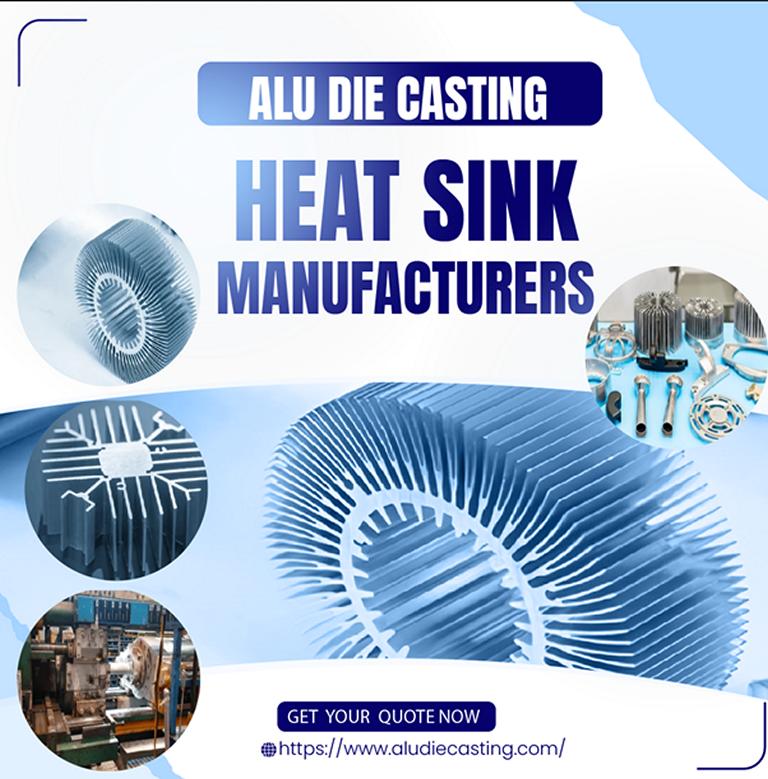Gaining an Understanding of the Extrusion Process for Aluminum
It is possible to manufacture items with a cross-sectional profile by a method known as aluminum extrusion machining. This process involves forcing the material through a die. It is possible to compare this process to the act of placing toothpaste inside of a tube. In this particular instance, the toothpaste is the heated cylindrical aluminum bar, which is also referred to as an ingot, and the tube is the die.
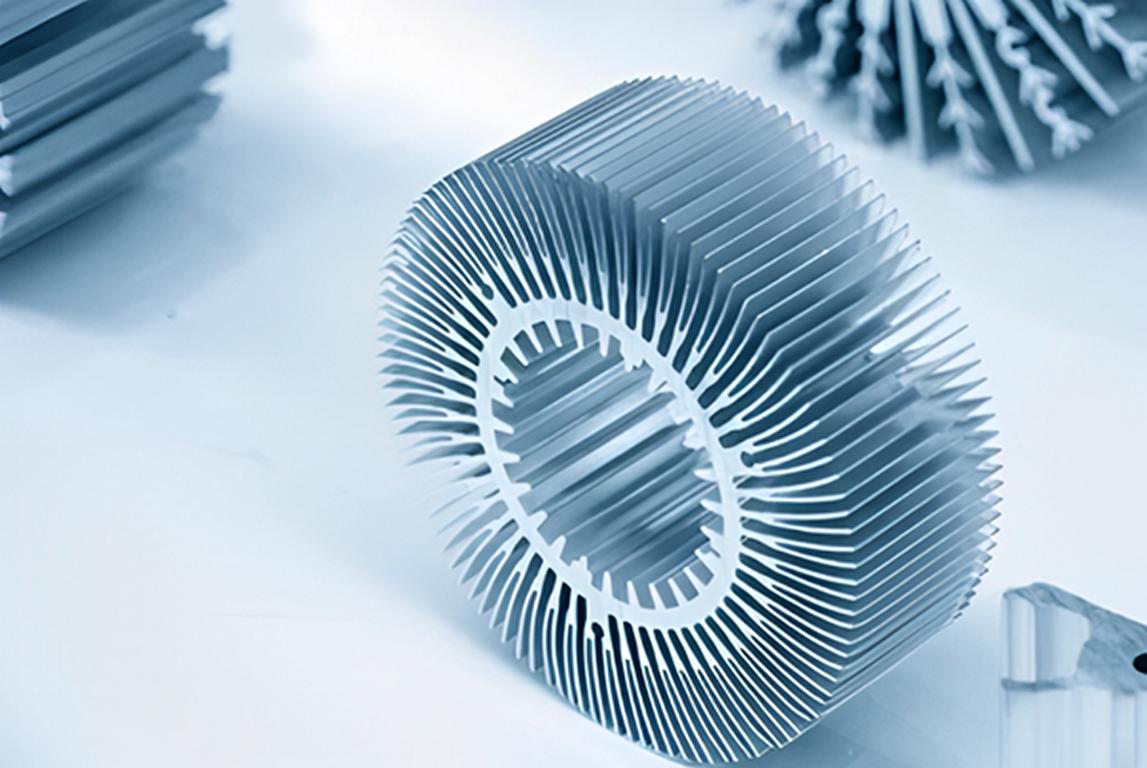
Here is a detailed explanation of each step:
Heating and Pressing: After that, the aluminum ingot is heated and then pressed through the die, which gives it the profile that is necessary for the product.
The material that has been shaped is released from the die and then cooled by either air or water after it has been molded.
Stretching: The profiles are pulled in order to relieve internal strains and obtain the appropriate proportions. This is done even though they have not yet been entirely set.
The profiles are first cut, and then they are aged, either by being heated or cooled, in order to achieve their ultimate strength.
Surface treatment and finishing are the last operations, which may include polishing or other treatments that are intended to improve the appearance of the surface and protect it against corrosion.
Can you explain what an aluminum extrusion machining center is?
An extrusion machining center is a special kind of machining center that is utilized for the purpose of precisely processing extruded aluminum profiles into the parts that are ultimately required. Sawing, deburring, drilling, turning, milling, and tapping are some of the procedures that are utilized in order to get the desired shape, which includes characteristics such as pockets and holes.
Extrusion machining centers come in a variety of configurations at CNM, each of which is characterized by extreme precision, rapidity, and dependability. Due to the fact that these machines are very effective in reducing the amount of time needed for production and decreasing the amount of waste that occurs during the processing of the products, they are an excellent choice for usage by manufacturers. The extrusion machining centers employed by CNM make the manufacturing process more efficient and provide high-quality work, which ensures that the aluminum extrusions are cut and profiled in accordance with the requirements that are necessary.
Machining aluminum and aluminum alloys requires careful consideration of a number of factors.
The cnc extrusion machining of aluminum alloys is significantly impacted by the elements that are listed below.
A Force That Cuts
There is a significant difference in the amount of cutting force required when working with aluminum alloys in comparison to the force required when working with steel. As an illustration, the amount of force that is necessary to machine aluminum is approximately one-third of what is necessary for low-carbon steel; hence, chip removal is three times more effective to mill aluminum. A good example of this would be the aluminum alloy 2017A, which has the same cutting force as low-carbon steel yet has mechanical qualities that are comparable to those of the latter.
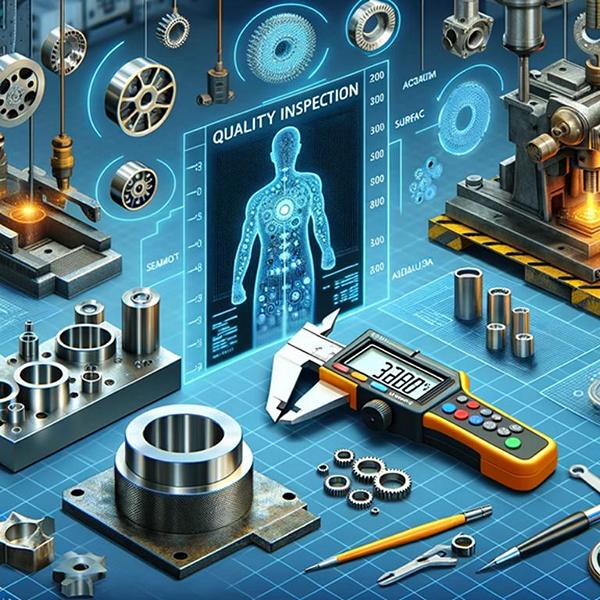
Instrumentation
The cutting tools that are utilized in the process of machining aluminum alloys are required to possess a particular shape. The cutting edges must to be as sharp as they possibly can be, and the tool faces ought to be smooth in order for them to be able to shed the swarf and not adhere to their surface. There are a variety of cutting angles that vary depending on the type of alloy; nevertheless, the rake angle should be greater than six degrees and can even be twelve degrees. When dealing with alloys that contain up to seven percent silicon, it is recommended to make use of the tools that are combined with the application of TiN or TiCN coatings through the use of PVD deposition. The rake angle that is recommended for diamond coated carbide tools and polycrystalline diamond (PCD) tools is fifteen degrees. Due to the fact that the appropriate tools are utilized in this operation, it is significantly longer than the ones that are used for machining steel. When it comes to the 2000 and 7000 series alloys, the high-speed spindles that are used in the special machines are capable of achieving a machining speed of between 2000 and 3000 meters per minute. For example, a tool with a diameter of 12 millimeters can achieve a cutting speed of 50,000 revolutions per minute (rpm) when fed at a pace of 10 meters per minute (m/min). This results in extremely thin sheets and lightweight components.
The rate of cutting and the feed rate
Because aluminum alloys have a low modulus of elasticity, it is suggested that excessive rates of advance be avoided even in roughing operations. This is because of the low modulus of elasticity. The feed rate ought to be restricted to 0.3 millimeters per revolution at the most. When finishing procedures are being performed, the feed rate will be influenced by the surface finish that is required. The level of accuracy that is required for the final product will have an effect on the depth of cut that is used.
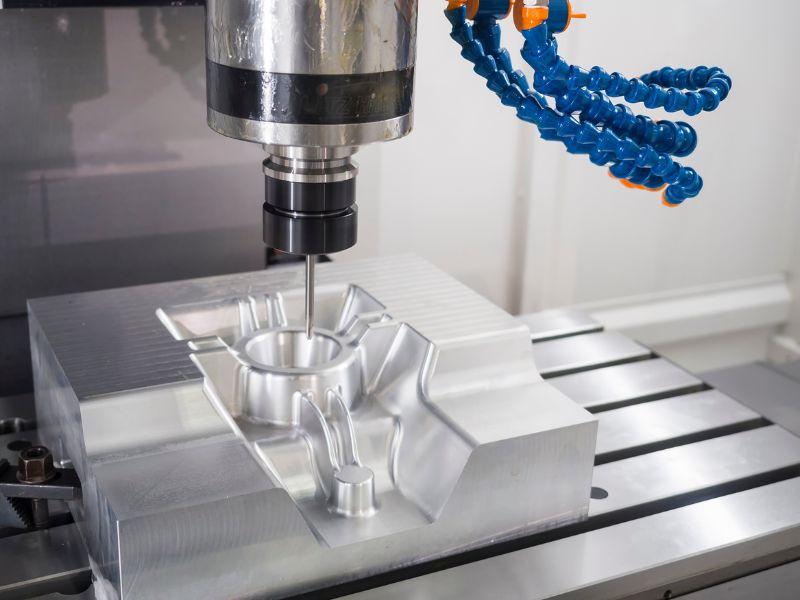
Sometime aluminum machining parts are used for injection plastic mold, please go to plastic mold technology page to know more about plastic molds.
The process of lubrication
Lubrication is essential when machining aluminum alloys for a number of reasons, including the fact that it lowers the temperature of the cutting region, prevents swarf from adhering to the tools, and removes swarf from the area where the machining is taking place. Lubrication can be broken down into three basic categories: Spray mists, full cutting oil, and oil emulsions are the three varieties of cutting fluids. Oil emulsions are the most widespread type of cutting fluid because they dissipate roughly 200 kg/J of heat. Spray mists are the least common type of cutting fluid. The use of coolants is beneficial for tapping operations as well as for minimizing friction. Whenever there is a significant amount of heat involved, spray mists are not particularly effective. In addition to being ecologically friendly, the composition of the cutting fluid should not react with aluminum alloys, produce stains or corrosion, have anti-bacterial agents to inhibit the growth of fungi, and contain anti-bacterial agents.
Metal extrusion machining offers a number of advantages:
Extrusion of machined aluminum offers a number of advantages, including the following:
Due to the following advantages that are linked with aluminum extrusion, the method of aluminum extrusion is one that is widely utilized in the current generation. This not only enables one to obtain complicated and exact forms of the required shapes, but it also enables one to make those shapes in a manner that will allow them to be used in the intended manner, which ultimately results in increased productivity and cost savings. As a result, the buildings are both sturdy and lightweight, making them perfect for industries that require light structures. These industries include the construction industry, the automobile industry, and the aeronautics industry. In addition to this, it is an effective method that does not call for a significant amount of material or energy and hence produces a little amount of waste. Machined aluminum extrusion, in conclusion, is both cost-effective and environmentally friendly, which contributes to an improvement in the quality of both the final product and the production process.
Composition of Aluminum That Is Suitable for Cold Extrusion
The process of cold extrusion involves pushing metal through a mold at a temperature that is not more than 150 degrees Celsius (300 degrees Fahrenheit). The aluminum retains its rigidity, and it is possible to produce pieces with thin walls, such as radiators, window frames, and door frames. However, the surface quality is higher and the shapes are more correct, which means that less post-processing is necessary. This method is slower than hot extrusion, but it produces more accurate shapes.
The Extrusion of Warm Aluminum
It is possible to perform warm extrusion at temperatures that are moderate, whereas the pace of hot extrusion and the precision of cold extrusion are both intermediate measures. Because of this, the precise temperature is determined by the properties of the material as well as the requirements that are anticipated to be satisfied by the end result. It is a method that is both quick and accurate at the same time, making it an intermediate way between the two.
Several Different Forms and Dimensions
An extensive variety of products, such as tubes, profiles, wires, sheets, and plates, can be formed through the process of extrusion using aluminum. Either they are straightforward, such as circular, square, or rectangular, or they are more complicated. The reason for this is that the shape of the outlet and the pressure that is given to the plunger are the factors that decide whether thin or thick sections of products will be created. In order to create exceptionally long lengths that are ideal for massive structures, this procedure can produce lengths of up to one hundred meters or even longer. Utilizing extrusion in conjunction with other metalworking techniques allows for the creation of a wider range of shapes and sizes, which can be achieved via the utilization of additional possibilities.
Interaction with Regards to Other Methods of Metal Treatment
The final product can be improved by combining this aluminum extrusion method with other processes that are utilized in the manufacturing process. For the purpose of achieving the desired qualities, the extruded shapes undergo additional processes like as cutting, drilling, bending, stamping, and pressing during the manufacturing process. However, the aluminum finish is shiny and will rust since it is an oxidized substance. The surface polishing increases the smoothness of the surface surface. Milling and turning machines that are controlled by computer numerical control (CNC) can be modified in a complicated manner, and that the amount of form changes is considerable while the dimensions are correct.
Applications for Machined Aluminum Extrusion
Extrusion of machined aluminum is utilized in the transportation, construction, and consumer goods industries. It is employed in the building industry for the fabrication of permanent fixtures such as pillars and supports because, despite its small weight, it is made of a material that is extremely strong. The production of automobiles makes use of it for the body frames, the engine parts, and other components that require such shapes in order to improve performance and fuel efficiency. Its application in the aerospace industry includes the formation of lightweight and robust structures, such as the wings, body, and undercarriage of aircraft. In a similar vein, some of the consumer goods that make use of this material include electronic devices, furniture, and sporting equipment. Even in the present day, the number of applications for machined aluminum extrusion is continuing to grow. This is due to the fact that new applications are being discovered.
Extrusion of machined aluminum has undergone a recent development.
There is a bright future ahead for machined aluminum extrusion since there is always innovation being made to make the process more efficient. For the purpose of improving the strength, corrosion resistance, and heat treatment of materials, new materials are being developed and manufactured. The combination of aluminum extrusion with three-dimensional printing allows for the creation of even more sophisticated and individualized forms, which may then be utilized in the robotics and medical equipment industries by the respective industries. In addition, the method is centered on the concept of recycling, as well as the exploitation of recycled resources and the decrease of waste produced, which makes it environmentally beneficial.
When it comes to heat sink efficiency, a comparison of CNC machining and aluminum extrusion processes
The production of heat sinks can be accomplished using a combination of CNC machining and aluminum extrusion, each of which has both advantages and downsides. The creation of heat sinks that are extremely complicated and specific can be accomplished through the use of CNC machining; however, this method can be very time-consuming and expensive, particularly if the heat sink is to be manufactured in large quantities. Aluminum extrusion, on the other hand, is better suitable for the manufacturing of heat sinks on a large scale, despite the fact that it might not be as flexible in terms of design as the former.
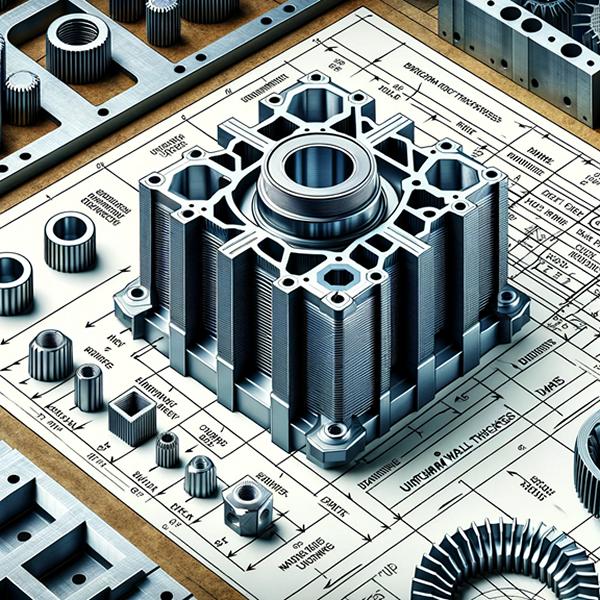
CNC machining and aluminum extrusion each have their own set of advantages and disadvantages; the particular method that should be utilized is determined by the design, quantity, and thermal characteristics of the application that is being considered. Every one of the aforementioned approaches can be utilized in the manufacturing process; the choice of which one to use is contingent upon the specifics of the project.
The Grades of Aluminum That Are Extruded the Most Frequently
The following are some of the aluminum grades that are typically used for machining:
Alloy 6063 made of aluminum
High extrusion properties are one of the distinguishing characteristics of the 6063 aluminum alloy. Additionally, it is resistant to corrosion and offers a reasonable amount of strength. This alloy has a surface finish that is satisfactory. Anodizing and architectural purposes are being served by this. Put to use in the frames of doors and windows. This material is suitable for use in furniture and automobile parts.
Alloy 6061 made of aluminum
Magnesium and silicon are the two primary components that make up the main components of the 6061 aluminum alloy. In addition to providing protection against rust and corrosion, it also offers strength and durability. The material can be worked and welded. It is applied in aerospace, truck frames, and marine fittings. Ideal for structural applications. Balances robust properties effectively.
6005A Aluminum Alloy
6005A aluminum alloy contains higher magnesium and silicon. Offers better strength than 6063 alloy. Maintains good levels of corrosion resistance and machinability. Recommended for ladders, platforms, and railings. Applicable for heavy construction and other industrial applications. Enhances mechanical characteristics.
6101 Aluminum Alloy
Aluminum alloy 6101 is very conductive to electricity. It is of moderate strength and also has good corrosion resistance. Applied to electrical bus conductors. Most suitable for power transmission lines. Transmits power in multiple uses successfully. As is generally known, it possesses excellent properties. check 6061 die casting page to know more.
Alloy 6082 made of aluminum
There is a higher concentration of manganese in the 6082 aluminum alloy. Extremely high strength and excellent resistance to corrosion. High weldability and the ability to be heat treated. The appropriate choice for cranes and bridges. Employed in the transportation and offshore facilities industries. resistant to stress and long-lasting for applications that are subjected to stress.
Alloy of Aluminum from 7075
Aluminum alloy 7075 is a robust material. Zinc makes up the majority of its composition. Outstanding strength-to-weight ratio in comparison? This technology is utilized in the aerospace industry as well as the production of sporting goods. High-stress components contain this material. It is the foundation for a variety of military apparatus and aircraft structures.
Aluminum Alloy Number 1100
The 1100 aluminum alloy is extremely near to having a substance that is composed entirely of aluminum. Outstanding resistance to corrosion, as well as excellent electrical conductivity. High degrees of thermal and electrical conductivity are present. There is a good workability for the various applications. The chemical and food industries both make use of this. It is applicable in heat exchangers as well as other particular uses.
Considering the Technical Aspects
The mechanical properties of a material can be improved through the application of heat treatment. 60% of 6061 and 70% of 7075 are in the T6 temper. 6063 is the recommended material for anodizing and surface finishing. Increasing the amount of silicon in a material results in an increase in its machinability. In terms of weldability, 6061 and 6082 are also good options. By selecting the appropriate material, it is possible to attain the greatest potential results.
Industrial Capabilities for Aluminum Extrusion Manufacturing
Every type of extrusion service is available from CNM, which is the most successful aluminum extrusion company in China. Aluminum extrusion, fabrication, cnc extrusion machining, and finishing are just some of the services that we offer to meet your requirements for aluminum goods. Our clientele come from a wide range of industries, including the aerospace and automotive industries, and we sell aluminum to them.
Help with the Design
In order to guarantee that the extrusion profile designs are viable in terms of manufacturing and tooling die-making, our extrusion professionals at CNM are actively involved with the customers. This technical help is of utmost significance in the process of transforming ideas into goods that can be physically constructed.
The Extrusion of Aluminum
For close to twenty years, CNM has been operating in the aluminum extrusion industry. The company is involved in the production of both conventional and specialty aluminum extrusions. The fact that our extrusion presses range from 1250TON to 4500TON demonstrates that we are able to fulfill even the most stringent requirements that our customers have. Extruded aluminum can be obtained in a wide variety of shapes, each of which can be tailored to meet the specific requirements of the aforementioned application.
Finishing of the Surface
CNM is one of the top 10 aluminum die casting manufacturers in China that offers a wide variety of finishing options, which can be used for a variety of purposes, including the protection against corrosion in a variety of industrial applications or as ornamental architectural embellishments. In addition to powder coating, anodizing, wood grain, PVDF painting, and wet painting, we also offer RAL colors powder coating. Through the use of CNM, your projects will have the appropriate finish and appearance.

